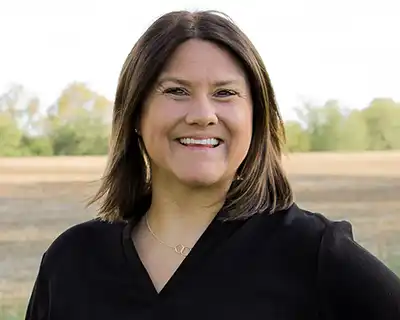Throughout 2021, Trust In Food is inviting leaders of the Foundational Partners of America’s Conservation Ag Movement to share their vision for the future of conservation and sustainability in U.S. agriculture. In this post, we spotlight Dr. Brett Kaysen, senior vice president of sustainability, National Pork Board, an ACAM partner.
Tell us a bit about yourself. How did you arrive in this leadership role within your organization, and how does a commitment to sustainability inform how you show up to work each day?
I’m a farm kid. I grew up with pigs my entire life and have always loved them. That inspired me to a career as an animal scientist. I thought, ‘Isn’t that cool? You can become a scientist focused on pigs.’ The Pork Board was a logical fit. I like people, and I was recruited to join in sustainability. I’ve always been a believer in using management systems to solving problems. I joined the team three years ago as assistant vice president, as an N of 1, and built the team to a robust, talented group. I’m so excited. It’s a fun job, and I’ve enjoyed every day.
What’s one book you’ve read recently that’s challenging how you think about conservation or the future of food and agriculture?
One book I recently completed that fits, by John Maxwell, is “LeaderShift”. The other one is “The 4 Disciplines of Execution,” by Chris McChesney. Some will say, ‘But Brett, there’s nothing in there about sustainability, stewardship or conservation.’ But they fit because the way we’re approaching this challenge in sustainability in agriculture takes a LeaderShift mentality, and it starts with leaders. We’ve got to think differently than we’ve ever thought to lead our industries into prosperity. You’ve also got to be able to execute on that and have ruthless focus on wildly important goals to move forward in the strategy we have around sustainability.
It’s going to take big leaders that are willing to think different and execute at a high rate of speed.
In a sentence, describe National Pork Board for executives in our audience who are unfamiliar with your work.
The National Pork Board’s mission is to do research, education and promotion of pork products on behalf of the 62,000 pig farmers that pay into the checkoff, to ultimately build trust and add value to the pork supply chain. That is our simple mission, although a challenge.
What is the biggest sustainability challenge your organization is facing, and how are you navigating possible ways to address and overcome that challenge?
It’s more of an opportunity than a challenge: The opportunity is to continue to bolster our relationship with the United Soybean Board and the National Corn Growers Association and work synergistically because of the amount of bushels of corn and soybeans that pigs consume every year.
We feed pigs predominantly corn and soy, which makes them efficient and sustainable protein. But we also understand that comes with ramifications for the environment. Those national associations are working in conjunction with state associations to bolster soil health. I believe sustainability starts with soil health. Pig farmers play a role there not only in the feed pigs consume but also this magical thing called pig manure, which we incorporate back into the soil to keep those regenerative practices going.
What are some of the most exciting sustainability initiatives underway for pork producers and the pork industry today, building on the We Care commitment? Where are you headed in 2022, and how can other segments of the value chain best engage to support producers on this journey?
Building on the We Care commitment, we’re going beyond that to bolster the proof points of how we’re getting better. You’ll hear more out of us after the first of 2022 about announcing pork industry sustainability goals, metrics and KPIs that we’ll measure, monitor and report against.
We’ve been going farm to farm since March 2021 creating sustainability reports for pork farmers and also corn and soy farmers. We’ve developed 70-plus reports for farmers proving their sustainability across 13 states. The magic is real data to prove our commitment to continuous improvement. We’ll continue to compile and scale in 2022.
Animal health and the prevention of foreign animal diseases is a major focus for pork producers. Can you talk about the work being done to mitigate risk and preserve the economic sustainability of pork operations?
Priority No. 1 for checkoff dollars is to prevent and prepare for a foreign animal disease. When we use the example of African swine fever and how it has decimated the pork population of other countries, obviously that’s not a sustainable business model when you have the tragic death of pigs throughout wide geographies. Thirty percent of U.S. pigs are exported to feed the world. Pork is nutrient dense from a diet perspective. We play a huge role here.
It starts with our partners at USDA as well as state animal health officials to protect and prepare our borders to the best of our ability. A tangible example of a tool we are using on behalf of checkoff-funded investments is called AgView. It’s simply contact tracing for pigs. Coming out of the pandemic, folks can relate to that. Producers have funded the tool. It allows us to track movements of where pigs go in a digital space so we can continue to think about if—heaven forbid—we had a foreign animal disease, we could create control zones as quickly as possible to continue to have business continuity in this country and, hopefully, be able to leverage that with our international partners.
It is a powerful and robust tool. Nothing like it has been done before in the industry. We’re very proud to lead the industry from the front.
Feed is a crucial input for pork producers, yet tracing its origins and understanding the sustainability impacts are complex for all segments of agriculture. How is the National Pork Board working to assess and improve our understanding of the role of feed in sustainable farming systems?
My perspective is that we should make the impossible possible. I say it that way purposely. To be honest with you, I often hear, ‘There are a lot of acres of corn and soy that go into feeding a pig, and it gets mixed together. There’s no way we can source and verify where it came from.’ I’m not a fan of, ‘We can’t, it’s impossible.’ Let’s figure out how we can and make it possible. We might not have the technology today to take it back to a particular plant at a particular field. But technologies do exist to ID grain-shed geographies where a crop came from.
We met with a group the other day using biotags to understand and biologically tag corn or soy and be able to verify where it came from. It’s still acceptable for human health consumption and animal health consumption. It’s cool technology—and that’s just one technology. We need to continue to challenge ourselves today and think about the innovation and science and the way it’s developing, what the future state could be. I think we need to lean into that.
What sustainability trends have you most excited and optimistic about the future of U.S. agriculture and farming in the next four years, relative to National Pork Board’s sustainability priorities?
I think agriculture is the solution to the problem. Animal agriculture, as well as crop production, is a solve to some of the challenges that we face. That gets me excited. We can take a proactive approach to having a global impact beyond nourishing the world and actually saving the planet and increasing the health and longevity of the planet. There are some out there who say, ‘We’re not part of the solution because we’re not part of the problem.’ We do use natural resources to produce a fantastic protein, bottom line. We need to improve our efficiency and augment that to best of our ability. With the work of corn, soy and pork, we can have a really big impact in mitigating environmental challenges.
What one sustainability trend or issue keeps you up at night and gives you heartburn?
It’s the discussion around greenhouse gas emissions. The reason it keeps me up at night is I know it’s important. We’re leaning into it as an industry. But it’s also something that’s challenging to measure, monitor and report. It is an evolving science. Marguerite Tan, director of environmental programs at National Pork Board, says it best: You can’t put a flow meter on greenhouse gas emissions like you can on other things. I know we need to be proactive and engaged. There are models that are directionally correct, but there are still a lot of unknowns. How do we refine the measurement? How do we define the measurement? How will the measurement change over time? We’re learning. It’s evolving, and it’s changing.
What’s the single most important action step that conservation- and sustainability-oriented food and ag professionals should be taking in the next 12 months?
I would challenge us all to think about sustainability as a management systems approach and understand that there’s tradeoffs. When we look to make a practice change in agriculture, there’s a tradeoff that impacts another piece of that system. I relate it to a balloon. You blow it up for a birthday party, you start to push on balloon and something else pushes out in another spot. There are constant pushes and pulls. We need to be willing to look at that and think holistically. At the end of the day, it has to be fiscally sustainable for the producer. They’re ready, willing and able to deploy, but if financially they cannot compete in today’s global marketplace, agriculture’s not a sustainable business.



